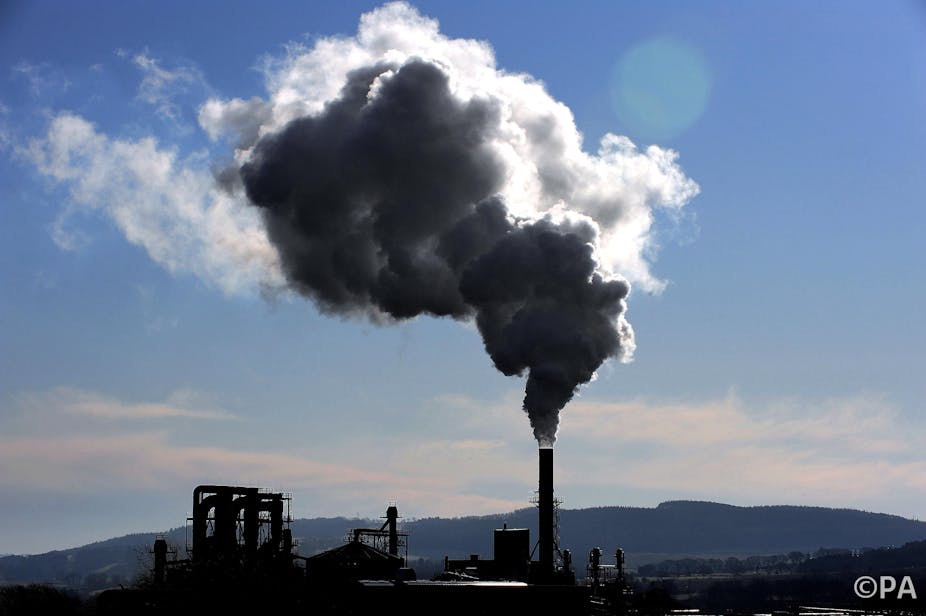The Energy Technologies Institute recently reported that without carbon capture and storage (CCS), the cost of reaching the UK’s climate change targets will double from around £30 billion per year in 2050. So how does it work?
The first step is to capture carbon dioxide (CO2) emitted from burning fossil fuels at power plants and from energy-intensive industrial processes, such as cement works or steelmaking. This is the most likely technological route to reducing CO2 emissions, since capturing CO2 directly from the air, even if feasible, would be very costly.
The CO2 is separated from the other gases coming out of power station chimneys using specifically designed chemicals such as amines, ammonia and other sorbents (absorbant materials). This first, capture-step is able to remove about 90% of the CO2 emitted, and represents about 70% of the overall costs (£35-60 per tonne of CO2). This process is not new - it’s been used for many years in the oil and gas sector, but has yet to be deployed on a large scale.
Once the CO2 is captured, it must be transported from the source to storage. Shipping and transportation by pipeline are considered as major options in the near term. However, commercial scale deployment in the UK will require extensive pipeline networks. This raises a very important question, can we reuse existing gas pipelines, particularly offshore, for CCS operations? This is unlikely without modifications to the existing infrastructure. Pipeline corrosion from impurities present in the captured CO2 is a potential risk. So there is more work to be done on CO2 transport infrastructure and alternative pipeline materials.
Out of the air, into the ground
Finally the CO2 is permanently stored. Deep geological formations are currently considered the most promising sites for carbon sequestration. By taking advantage of the high pressure and temperatures that naturally occur deep underground, CO2 can be prevented from escaping to the surface through different trapping mechanisms. The way these interact with each over time increases the stability of the stored CO2. For example, one million tonnes of CO2 have been stored annually at the Sleipner project in the North Sea since it started operating in 1996. While for more than 30 years, CO2 has also been injected in geological formations to aid enhanced oil recovery.
In any case, the important factor of any CCS project is to guarantee that the stored CO2 stays confined without seepages occurring. A variety of well-proven monitoring systems are available, derived from methods routinely applied in gas and oil exploration. Laboratory experiments and study of natural emissions of CO2, such as from geothermal areas, are also used to assess any potential environmental impact. However, first and foremost, the accurate selection of the storage site is key to eliminate the probability of leakage. This is then to be matched with reliable monitoring techniques to promptly detect any leaks and allow for any reaction required.
Don’t just store it, use it
Today there is an increasing interest in making some use of the captured CO2. Better industrial use of CO2 (currently only around 0.5% of annual emissions) would build new business markets and would reduce the need for long-term storage. Several technical questions are currently being addressed that would allow new chemical, photochemical, electrochemical, reforming, biological and inorganic methods to convert and use captured CO2 into something useful. A significant amount of research on innovative CO2 uses comes from the food industry and oil and gas sector. Ultimately, success will depend on whether technologies can reduce CO2 emissions while creating commercially viable products such as oils, chemicals, fertilisers and fuels.
Recently, Skyonic Corporation in the US (a joint venture between BP and ConocoPhillips) has started operating the world’s first commercial CO2 capture and utilisation plant in the world. Using low-cost chemical inputs to capture and mineralise CO2 into valuable carbon-negative products such as hydrochloric acid and sodium bicarbonate, it is expected to remove 300,000 tonnes CO2 per year from a cement plant, and create 200 jobs.
The International Energy Agency has highlighted CCS as key to mitigating global CO2 emissions. But deployment remains slow, with only a handful of commercial projects currently in operation.

